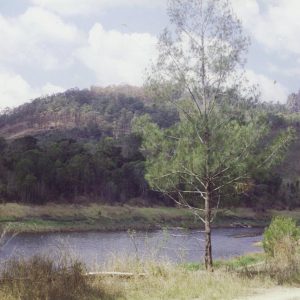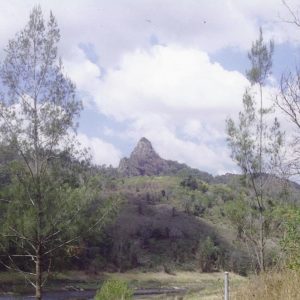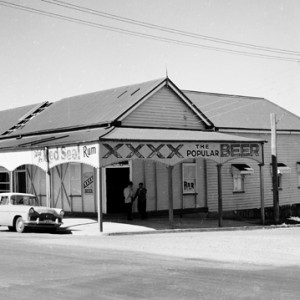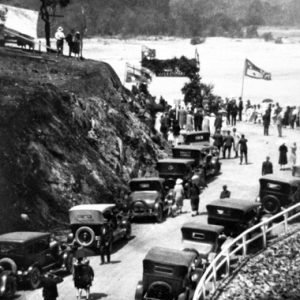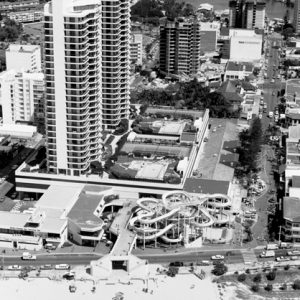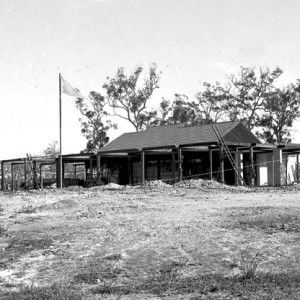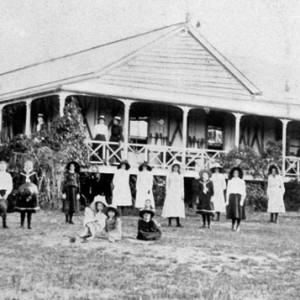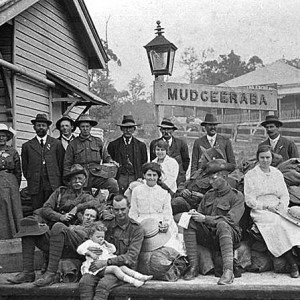
Pages Pinnacle, formerly Pine Mountain, is a 400m high tertiary rhyolite volcanic plug on a ridge between Springbrook and the Numinbah Valley. It is located above the Nerang River within the Numinbah State Forest. The Yugambeh people called the pinnacle kundohikulli meaning rock shaped boat. The pinnacle, similar to other ancient volcanic landmarks in the Gold Coast and northern New South Wales hinterlands, is an acid volcanic rock containing at least 66% silica.
The landscape of the Numinbah Valley and Springbrook plateau is a remnant of the northern side of the huge shield volcano that dominated the region for millions of years. The volcano was built up of highly mobile basalt lavas that, although centred on Mount Warning in New South Wales, spanned a distance of about 80km as lava constantly flowed great distances from the volcano.
Approximately ten million years ago the volcano began to die and the remaining lava solidified and plugged its numerous vents. Over millennia, weathering and water erosion sculpted the volcano into a caldera with spectacular volcanic formations known as plugs.
The Mount Warning caldera is the largest and most significant of its age in the world. Rainfall that feeds streams and powers the many waterfalls in the area continue to shape the landscape in an ongoing process of erosion. The unusual volcanic formations left from this erosion process include Egg Rock and Pages Pinnacle in the Numinbah Valley.
Pages Pinnacle was named after Sir (Dr) Earle Christmas Grafton Page (1880-1961) who was born in Grafton, New South Wales. Page studied medicine as a young man and became a well-respected surgeon who established a private hospital in South Grafton in the early 1900s.
In 1908 he began to purchase land and invest in the timber industry in Kandanga in central Queensland. He also acquired land in Nerang and in the Numinbah Valley where he utilised the skills of permanent residents and timbermen like Hugh Guinea to harvest and transport timber from the forests to market. Page’s interests were not limited to the timber industry. He also ran herds of cattle and operated dairies.
In 1913 Page entered local politics as an alderman on the South Grafton Council. He became a strong advocate for the separation of the northern New South Wales region from the influence of Sydney and formed the Northern New South Wales Separation League. He also had a keen interest in hydro-electricity schemes.
Page enlisted as a doctor during the First World War and served in Egypt, England and France before returning to Australia in 1917. He returned to politics and initiated the Nymboida hydro-electric scheme and was responsible for officially opening the facility, in his new role as Federal Treasurer, in 1924. Pages’ political career included being party whip and serving as the caretaker Prime Minister in 1939 for nineteen days following the death of Prime Minister J A Lyons and prior to the election of Sir Robert Menzies as the leader of the coalition government.
Page maintained and visited his land holdings and residences on the South Coast and was active in his advocacy for road improvements and bridges through the Numinbah Valley. He was also vocal in his displeasure at the impact fuel rationing would have on the timber industry which was reliant on heavy vehicles.
In 1951 Page put up the family’s Gold Coast properties for sale. The auction held in Southport and presided over by Mr A R Andrews was the largest auction of land held in Southport at the time. The area consisted of 8,500 acres and, including improvements and stock, was estimated at a value of over £30,000.
Some of the holdings included land in Nerang, Advancetown and forest leases around Pine Mountain in the Numinbah Valley which are understood to have included the pinnacle in its lease. The land at Numinbah which had been two dairy farms that had been converted to land for fattening cattle was eventually sold to the Christmas family, with the Burns family taking residence in a new home built on the property.
After selling all his land in Queensland, Page retired with his wife Ethel (nee Blunt). Ethel passed away in 1958. In 1959, Earle Page married Jean Thomas at St Pauls Cathedral in London. He passed away in Sydney in 1961.
- Upper reaches of the Hinze Dam catchment area, 26 September 2004. Susan Mills, photographer
- Pages Pinnacle near Advancetown, 26 September 2004. Susan Mills, photographer
Sources of information and further reading
- Australian Women’s Weekly (Sydney, N.S.W) 12 Jul 1972.
- “PROPERTIES PASSED IN” Brisbane Telegraph (Qld. : 1948 – 1954) 7 July 1951: 7 (LAST RACE). Web. 13 Dec 2017 http://nla.gov.au/nla.news-article216560258
- Geocache description. Pages Pinnacle www.geocaching.com/geocache/GC1YYJ2_pages-pinnacle?guid=d00338d3-758a-434a-b7ca- Accessed 10/8/2017
- Nature, culture and history. Department of National Parks, Sport and Racing. http://www.npsr.qld.gov.au/parks/springbrook/culture.html Accessed 10/08/2017
- “NUMINBAH NEWS” South Coast Bulletin (Southport, Qld. : 1929 – 1954) 17 June 1953: 6. Web. 13 Dec 2017 http://nla.gov.au/nla.news-article226266974
- NUMINBAH NEWS (1952, February 20). South Coast Bulletin (Southport, Qld. : 1929 – 1954), p. 2. Retrieved December 27, 2017, from http://nla.gov.au/nla.news-article225641165
- UNTIL THE WATERS RISE (1972, July 12). The Australian Women’s Weekly (1933 – 1982), p. 56. Retrieved December 27, 2017, from http://nla.gov.au/nla.news-article52260750
- Plan Would Ruin Timber Industry (1940, July 13). The Telegraph (Brisbane, Qld. : 1872 – 1947), p. 9 (CITY FINAL LAST MINUTE NEWS). Retrieved December 27, 2017, from http://nla.gov.au/nla.news-article186281653
- NUMINBAH NEWS (1952, February 20). South Coast Bulletin (Southport, Qld. : 1929 – 1954), p. 15. Retrieved December 27, 2017, from http://nla.gov.au/nla.news-article225641265
- NERANG SHIRE COUNCIL (1946, August 14). South Coast Bulletin (Southport, Qld. : 1929 – 1954), p. 4. Retrieved December 27, 2017, from http://nla.gov.au/nla.news-article194852997
- NUMINBAH NEWS (1952, October 22). South Coast Bulletin (Southport, Qld. : 1929 – 1954), p. 9. Retrieved December 27, 2017, from http://nla.gov.au/nla.news-article226261034
- PROPERTIES PASSED IN (1951, July 7). Brisbane Telegraph (Qld. : 1948 – 1954), p. 7 (LAST RACE). Retrieved December 27, 2017, from http://nla.gov.au/nla.news-article2165602581
- SIR EARLE PAGE TO WED (1959, July 17). The Canberra Times (ACT : 1926 – 1995), p. 12. Retrieved December 27, 2017, from http://nla.gov.au/nla.news-article114847754
- SIR EARLE PAGE AND BRIDE (1959, July 21). The Canberra Times (ACT : 1926 – 1995), p. 1. Retrieved December 27, 2017, from http://nla.gov.au/nla.news-article103125661
- Serle, Geoffrey, Gen. ed. Australian Dictionary of Biography, Vol 11 1891-1939 Nes-Smi. Melbourne University Press : Carlton Vic., 1979.
- Stevens, N.C. A Guidebook to field geology in Southeast Queensland . University of Queensland Press. : St Lucia, Qld. 1973.
- Willmott, Warwick. Rocks and Landscapes of the Gold Coast Hinterland,. Geological Society of Australia, Queensland Division. 2nd Ed.1992
- Hall, P., Yaun, D. & Gilmont, N. Numinbah Valley: A Social and Natural History 1840’s – 1988. The Numinbah Valley Bicentennial Committee. : Nerang, Qld. 1988.
